
A Managing Director taught me the meaning of the phrase Never Walk Past A Quality Problem. Sitting in the reception area of his company’s offices, I saw him park his car and walk toward the main entrance.
Suddenly he dived into the hedge and emerged with an empty drink can. It was 7.30 in the morning and the can had obviously been thrown from the nearby main street during the night. The MD explained his actions in the following way.
“I refuse to walk past a quality problem, otherwise I have said it is okay. If we don’t keep our hedges and car parks clean, visitors will think we don’t pay attention to our products.”
Good leaders aim to build an excellence culture rather than an excuse culture. They encourage the behaviour they want repeated and never walk past a quality problem. Let’s explore how they follow this approach.
They Clarify The
High Quality Standards
Imagine you lead a team and want to set high quality standards. The first step is to act as a good model. This is because people will watch what you do rather than what you say.
How can you then encourage people to deliver the required standards? One approach is to instruct them to behave in certain ways. This may work for a while but it can also create a culture where people don’t think for themselves.
Another approach is to set the tone from the top but to also involve people in setting the required quality standards. It is then to give them the support they need to deliver the goods.
How to make this happen? One approach is to gather people together and invite them to take the following steps. You can ask them:
To focus on a specific activity where they want to deliver high quality standards – such as customer service, product quality, professional behaviour or another activity;
To describe the specific things they can do – plus the support they need – to deliver high quality standards in this activity;
To describe the specific benefits – to all the various stakeholders – of delivering high quality standards in this activity.
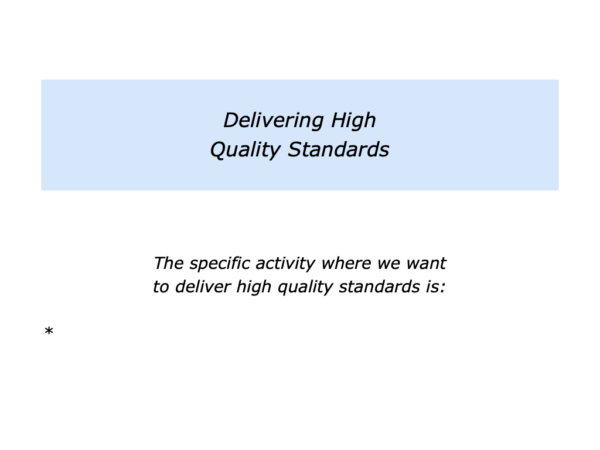
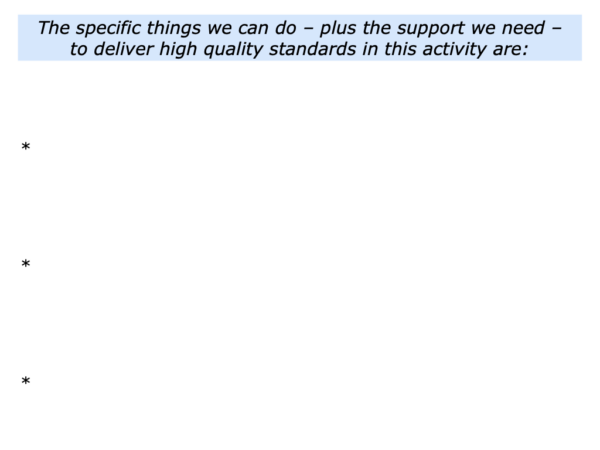
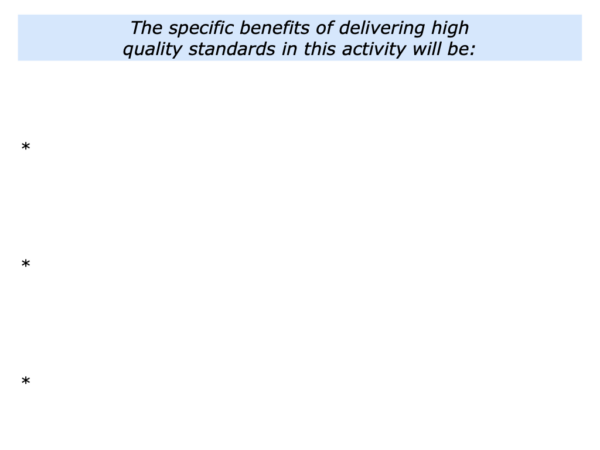
They Keep Communicating
The High Quality Standards
People sometimes need reminding about what good looks like. How to make this happen? Every Wednesday the MD mentioned above sent out an email called Weekly Wins.
In addition to highlighting business successes across the company, they described the specific ways that people had demonstrated the quality standards. He explained this in the following way.
“It’s easy to report acts of heroism. Like many companies, we have employees who drive through a blizzard from London to Glasgow to deliver an important package.
“Certainly we tell these stories, but it’s crucial to highlight the daily acts of people doing things the right way. So we publicise the efforts of people who are running the engine as well as those who are entrepreneurial.
“This reinforces the standards we want people to demonstrate each day.”
Some leaders also keep producing success stories that describe how people have delivered the high quality standards. These stories show what good looks like and encourage people to keep developing in these activities.
There are many frameworks for producing such stories. Here is one approach.
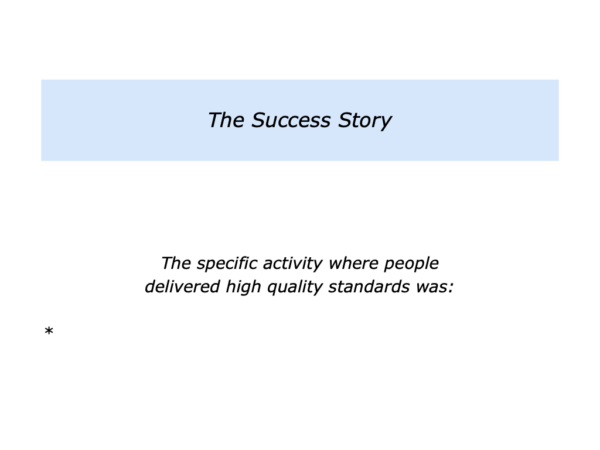
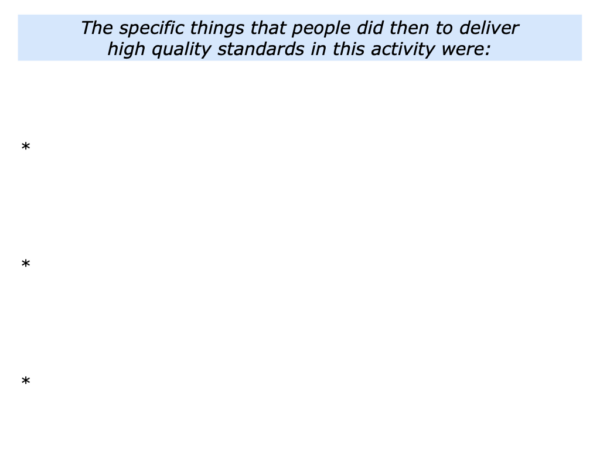
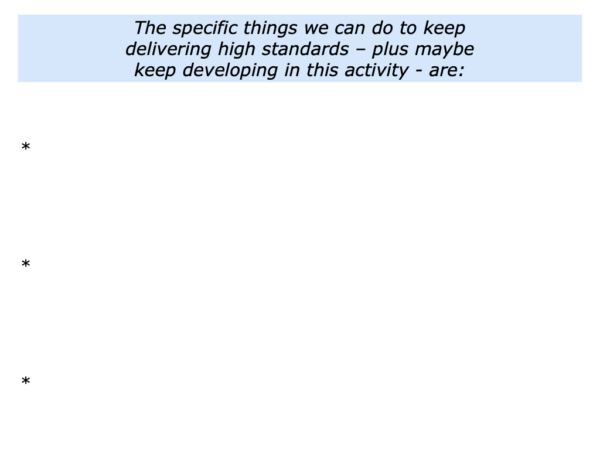
They Never Walk
Past A Quality Problem
Good leaders often take this approach in their work. They never walk past a quality problem whether it concerns the organisation’s principles, products or people.
There are many different scenarios where this approach may be important in order to maintain the desired high standards. Let’s look at one example.
Imagine the scene. It is 9.30 on a Monday morning and one team member arrives 30 minutes late for a 9.00 meeting at the office. The person then unleashes their frustration on the rest of the staff by making the following proclamation.
“What a terrible day. The trains are late, the traffic is terrible and today I am due to meet the client from hell. What a way to begin a Monday.”
What to do about such an entrance? You can ignore the person, confront them or adopt some other approach. The following example is one I witnessed when working with a company.
The leader asked the late arriving team member to make another entrance. They explained this in the following way.
“I wonder if you can replay that situation. Everybody has found it hard to get into work today, but we want to get on with the job.
“I would like you to go out and then come in again. This time, think about the impression you are giving to people in the office.
“I don’t want you to come in with a forced smile, but I do want you to think about the tone you are setting on a Monday morning.
“Do you want to try? It’s up to you.”
That approach may sound heavy but it worked. The team member smiled wryly, accepted the message and said they were sorry. They left the room and came in again 30 seconds later with a totally different attitude.
The leader was not looking for clones, but they did want people to behave in a professional way. Allowing the situation to have gone unchallenged would have given the message:
“It is okay to start the week by infecting other people.”
Team members must be able to express their feelings, but they must also understand the consequences. The way they behave can have a positive or negative effect on other people.
You will have your own way of never walking past a quality problem. This can be relatively easy when it applies to physical products or customer service. But it can be harder regarding human behaviour.
People must get the message that certain actions are encouraged whilst others are unacceptable. Corporate misdemeanours can often be traced back to ignoring people who behaved badly. The messages are:
Reward the behaviour you want repeated and never walk past a quality problem.
Let’s return to your own work. If you wish, try tackling the exercises on this theme. This invites you to think of a specific situation where you may want:
To not walk past a quality problem;
To instead give people a positive way forward by suggesting the quality standards to be delivered in the future.
Here is the exercise on this theme. This invites you to complete the following sentences.
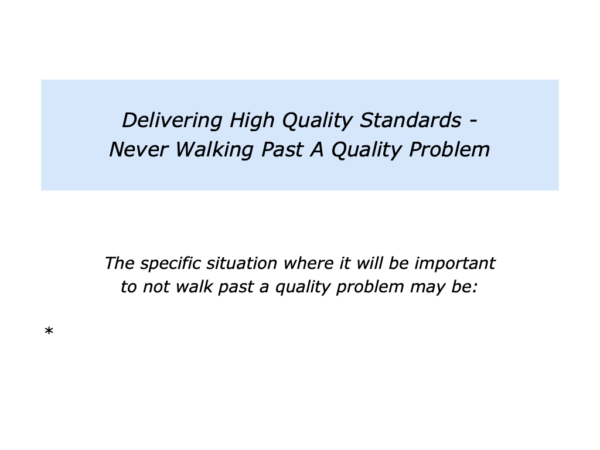
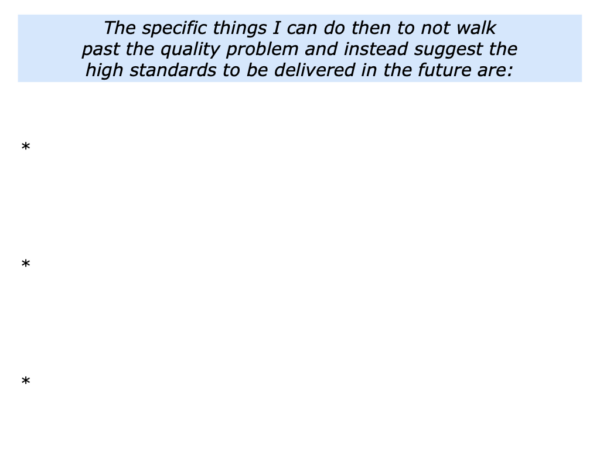






Leave a Reply